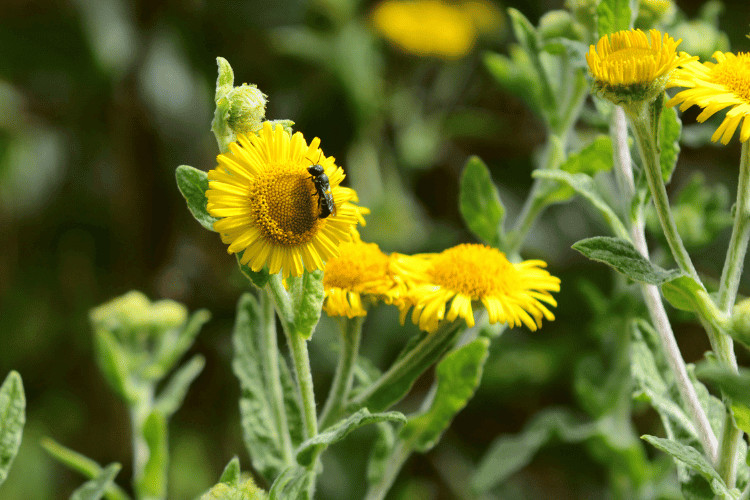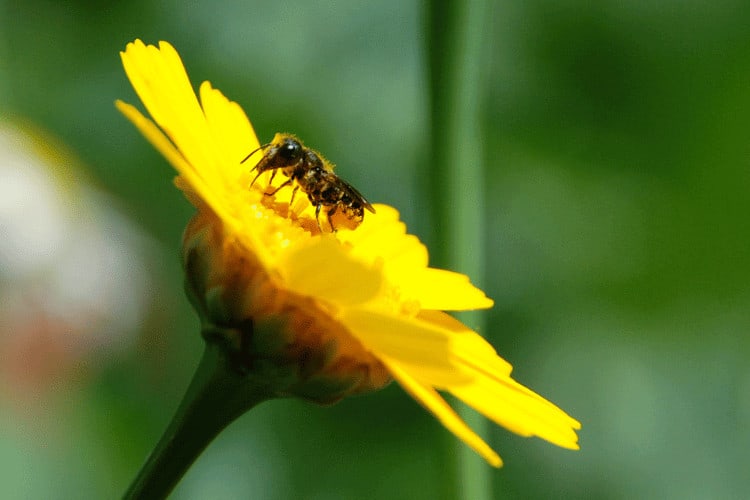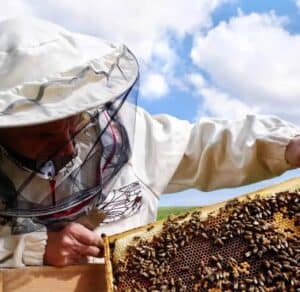Resin Bees (Heriades)
Resin bees are one of the bee species that aren’t known for producing honey. You can’t treat them as you treat honey bees and expect to sell some honey for profit.
However, resin bees are still excellent pollinators that do a lot for the ecosystem and agriculture. Let’s start by getting to know what they look like.
Description and Characteristics of Resin Bees

Resin bees, scientifically known as Heriades, have captured the attention of entomologists and nature enthusiasts alike for their unique features and behaviors.
Characteristics of Resin Bees
- Intriguing Nesting Behavior: These bees are renowned for their nesting habits. They construct individual partitions between rearing cells, separating each egg-laying site within their nests.
- Floral Affiliation: Resin bees have a particular affinity for flowers belonging to the yellow-flowered Asteraceae family. This preference shapes their foraging behavior and contributes to pollination interactions.
- Distinctive Copulation Strategies: Female resin bees exhibit fascinating pre-copulatory behavior and unique strategies for mating. Their copulations are marked by specific rituals that add to the intrigue of their reproductive lives.
- Vital Ecosystem Role: Resin bees, like many other bee species, contribute to the pollination of plants, facilitating their reproduction and supporting biodiversity.
What Is the Purpose of Resin Bees?
Resin bees play a vital role in their ecosystems. Their primary goal revolves around pollination, a crucial ecological service that contributes to the reproduction of numerous plant species.
As efficient pollinators of flowers, resin bees aid in the transfer of pollen grains, fostering plant diversity and maintaining the balance of various ecosystems.
Resin bees collect resin from plants and trees and then chew it up and mix it with saliva to form a pliable material that they use to construct their nests.
Resin bees have a variety of purposes for using resin in their nests. For one, it helps to waterproof the nest and protect the eggs and larvae from moisture.
Resin also helps to insulate the nest, keeping the eggs and larvae warm in the winter. Additionally, the resin can be used to deter predators, as it has a strong odor that many animals find unpleasant.
In addition to its practical uses, the resin also has some symbolic meaning for resin bees. The resin that they collect is often from plants that are considered to be sacred or medicinal, and it is believed to have healing properties.
Some resin bees even use resin to decorate the entrance to their nests, as a way of marking their territory and attracting mates.
Resin Bees’ Habitat and Foraging Preferences
Resin bees exhibit distinct habitat preferences that contribute to their ecological significance. These bees are commonly found in both European and North American regions, adapting to a range of environments.
They are often observed frequenting flowers, where they diligently collect pollen grains. These foraging activities are essential for the bees’ nutrition and the pollination of their preferred plant species.
The partitions between rearing cells within their nests serve as indications of their nesting behavior, reflecting their meticulous organization.
Where Can You Find Resin Bees
Resin bees are found in a variety of habitats around the world, including meadows, forests, and urban areas. They prefer to nest in sunny, open areas with sandy soil. They are also attracted to areas with plenty of flowers, as they need pollen and nectar to survive.
Some of the places where you might find resin bees include:
- Meadows: Meadows are a great place to find resin bees, as they provide plenty of sunny, open areas with sandy soil. Some of the flowers that resin bees are attracted to in meadows include daisies, sunflowers, and asters.
- Forests: Resin bees can also be found in forests, but they are less common than in meadows. This is because forests often have more shade and less sandy soil, which are less ideal conditions for resin bees. However, if you find a sunny, open area in a forest, you might be lucky enough to spot some resin bees.
- Urban areas: Resin bees can even be found in urban areas, especially if there are parks or gardens with plenty of flowers. Some of the flowers that resin bees are attracted to in urban areas include clover, dandelions, and goldenrod.
Resin Bees Life Cycle, Mating, and Nesting
The life cycle of resin bees follows a fascinating pattern that contributes to their survival and reproduction.

These bees are solitary, meaning they do not live in colonies like honey bees or bumble bees. Instead, they engage in a cycle that includes mating, nesting, and the development of their offspring.
Mating Behavior
Resin bees engage in complex mating behaviors. Females are known to exhibit pre-copulatory behavior, which involves interactions between the sexes before actual copulation.
These behaviors can include courtship rituals and specific postures adopted by the females. Successful copulation leads to the fertilization of eggs, which are essential for the next phase of the bees’ life cycle.
Nesting
Resin bees are known for their creative nesting behaviors. They construct their nests in pre-existing cavities, such as hollow stems or tunnels created by wood-boring insects.
These nests often contain partitions between rearing cells, providing individual chambers for each developing offspring.
The female bee collects pollen grains and mixes them with resin to create a protective wall or partition between the cells. This unique behavior showcases their resourcefulness in ensuring the safety and nutrition of their young.
Development and Emergence
The resin bee life cycle progresses through egg-larva-pupa-adult stages. After the female resin bee seals off the nesting chamber with the pollen-resin mixture, she lays a single egg on the pollen provisions. The egg hatches into a larva, which feeds on the stored pollen.
As it grows and matures, the larva eventually pupates, undergoing metamorphosis within the sealed cell. After completing their development, the adult bees emerge from the nest, ready to contribute to pollination and continue the cycle.
Importance of Resin Bees in Ecosystems and Agriculture
Here’s what Resin bees help ecosystems:
Pollinators: Resin bees are effective pollinators of various flowering plants. As they forage for nectar and pollen, they transfer pollen grains between flowers, facilitating the process of fertilization and subsequent fruit and seed production. Their role in pollination enhances plant reproduction and contributes to the overall biodiversity of ecosystems.
Biodiversity: By visiting and pollinating a wide range of flowering plants, resin bees contribute to the diversity of plant species within their habitats. This diversity has a cascading effect, benefiting other organisms that rely on these plants for food, shelter, and habitat.
In turn, a rich variety of plants supports the health of insect populations, birds, and other animals, forming a delicate web of interactions that sustains ecosystems.
Agricultural Benefits: Resin bees’ pollination activities extend to agricultural crops, where they enhance fruit and vegetable yields.
Their contribution to crop pollination can lead to increased crop quality and quantity, benefiting farmers and ensuring food security.
Common Questions About Resin Bees
What Do Resin Bees Eat?
Resin bees eat pollen and nectar, which they collect from a variety of flowers. They are especially attracted to flowers in the aster family, such as daisies, sunflowers, and asters.
The pollen and nectar provide the protein and carbohydrates that the bees need to survive. The pollen is also used to feed the larvae.
Resin bees do not make honey, as they are solitary bees and do not live in colonies. Instead, each female resin bee builds her own nest and provisions it with pollen and nectar for her young. The pollen and nectar are stored in individual cells, and the bee does not add any honey to it.
Are Resin Bees Dangerous?
Resin bees are not generally considered to be dangerous to humans. They are solitary bees, which means that they do not live in colonies like honey bees. This means that they are not as aggressive as honey bees, and they are less likely to sting.
However, resin bees can sting if they feel threatened. If you are near a resin bee, it is best to avoid making any sudden movements or loud noises. If the bee does sting you, the pain should be relatively mild and should go away after a few hours.
What Size Are Resin Bees?
Resin bees are about the size of honey bees, ranging in length from 7 to 16 mm (0.28 to 0.63 in). They are black with pale bands of hair on their abdomen. Their wings are transparent and lie flat on their backs when they are resting.
It is important to note that the size of resin bees can vary depending on the species. For example, the largest species of resin bee, Colletes inaequalis, can grow up to 18 mm (0.71 in) long.
It is also worth noting that resin bees are often mistaken for sweat bees, which are also small, black bees with pale bands of hair on their abdomen. However, sweat bees are not solitary bees and they do not build nests in the ground. Instead, they build their nests in rotting wood or other decaying materials.

How to Identify Resin Bees
Here are some of the key features to look for when identifying resin bees:
- Head Size: The large-headed resin bee stands out due to its relatively larger head compared to its body. This unique feature is one of the most noticeable traits of these bees.
- Coloration: Resin bees’ bodies can vary in shades of black, brown, or reddish-brown, with yellow markings adding to their distinctive appearance.
- Abdominal Partitions: One notable characteristic of resin bees is the presence of partitions between their rearing cells. These partitions create individual compartments within their nest, where they store provisions for their developing offspring.
- Hairy Body: Resin bees typically have a hairy body, which aids them in carrying pollen grains from one flower to another during their foraging activities.
How to Attract Resin Bees
Here’s how you can create an inviting environment for resin bees:
Choose Native Plants
Opt for a variety of native flowering plants that resin bees are naturally attracted to. These species often provide the right type of pollen and nectar that resin bees need for their diet.
Resin bees are particularly drawn to plants from the Asteraceae family with yellow flowers. Include species like sunflowers, daisies, and goldenrods to entice them.
Provide Nesting Sites
Leave some hollow stems and twigs in your garden or provide bee houses with appropriate cavities. Resin bees often use these spaces for nesting and laying their eggs.
Also, allow small patches of your garden to remain undisturbed, as some resin bee species are ground-nesters.
No Pesticides
Minimize or eliminate the use of pesticides and herbicides in your garden. These chemicals can harm resin bees and other beneficial insects.
Provide Water and Shelter
Place shallow dishes of water in your garden, providing resin bees with a water source for hydration.
Vegetation
Incorporate diverse vegetation that offers shelter from harsh weather conditions. Shrubs, bushes, and dense vegetation can create safe spaces for resting and nesting.
The Verdict
Resin bees are captivating creatures that play a vital role in ecosystems and agriculture. Their distinct characteristics, such as their large heads, and unique nesting behavior set them apart.
Resin bees’ contribution to pollination ensures the reproduction of various plant species, fostering biodiversity and supporting other organisms within their habitats.

Joseph Davis
My goal is to show that anyone can take up beekeeping and it can be a very rewarding hobby. I strive to share my experiences and answer any questions you may have.
